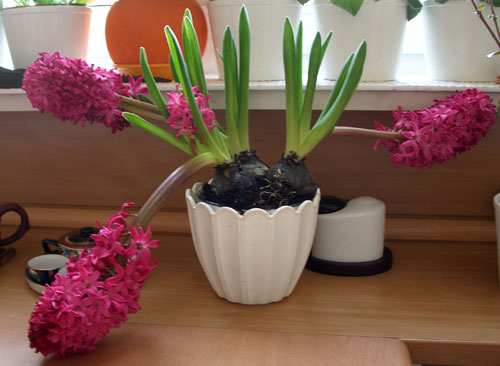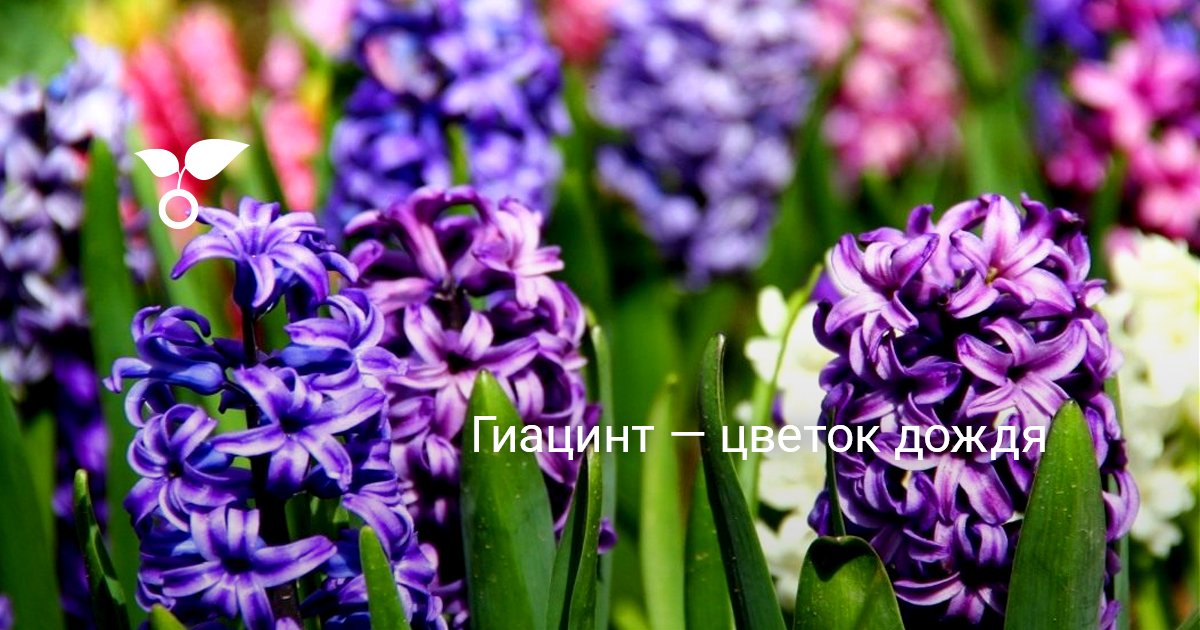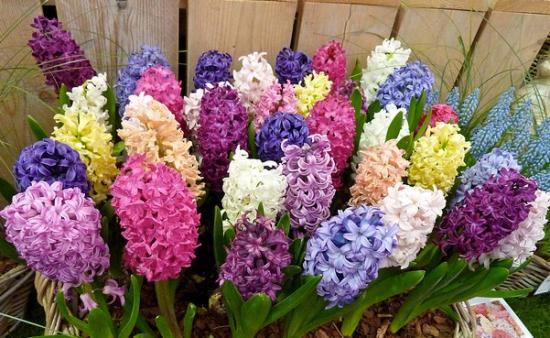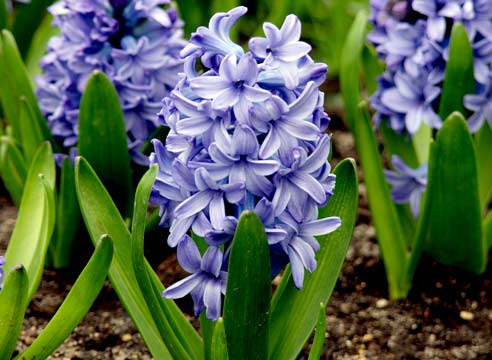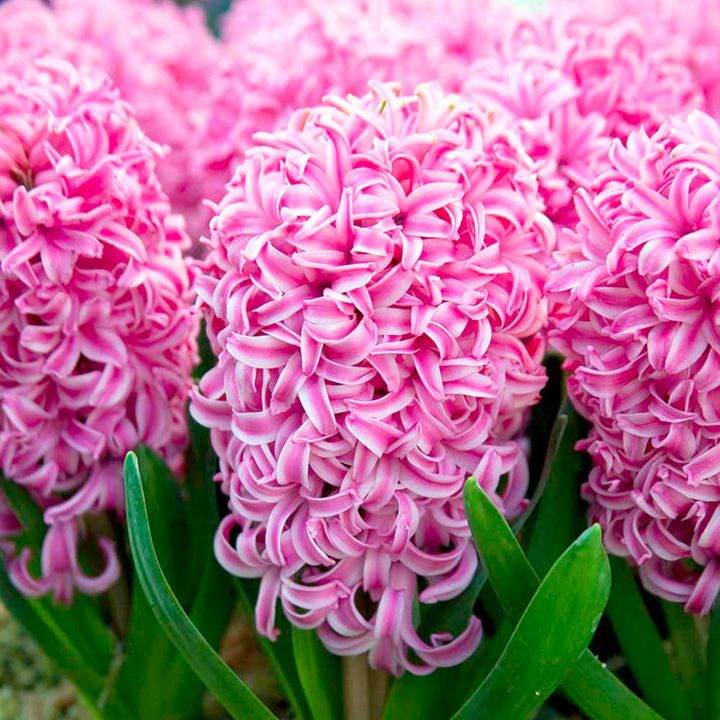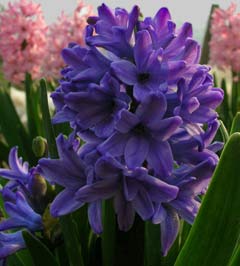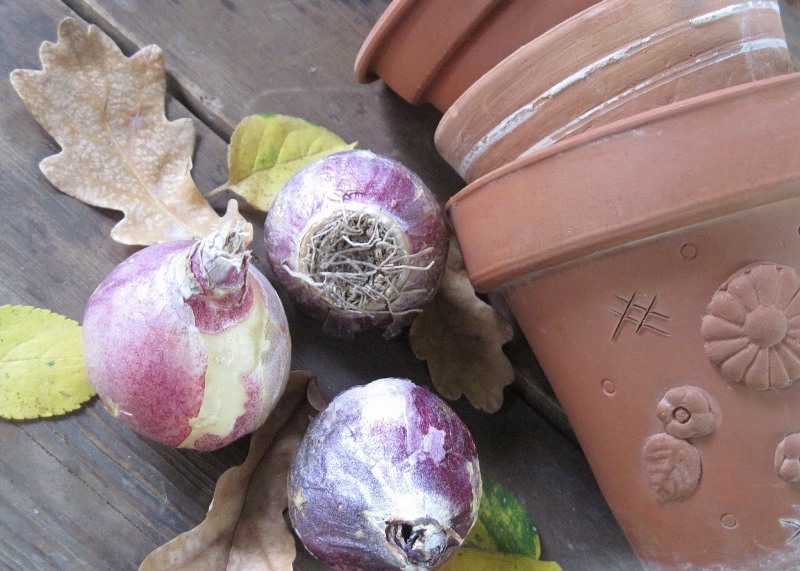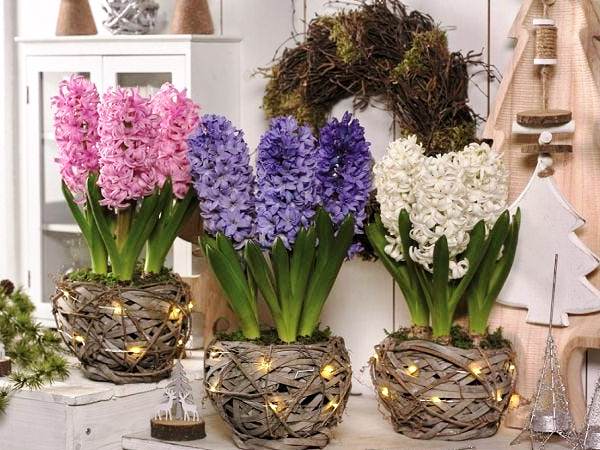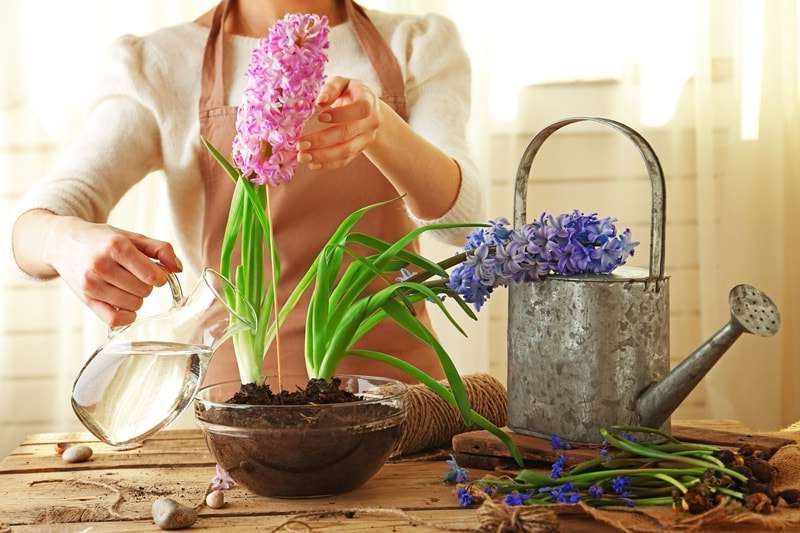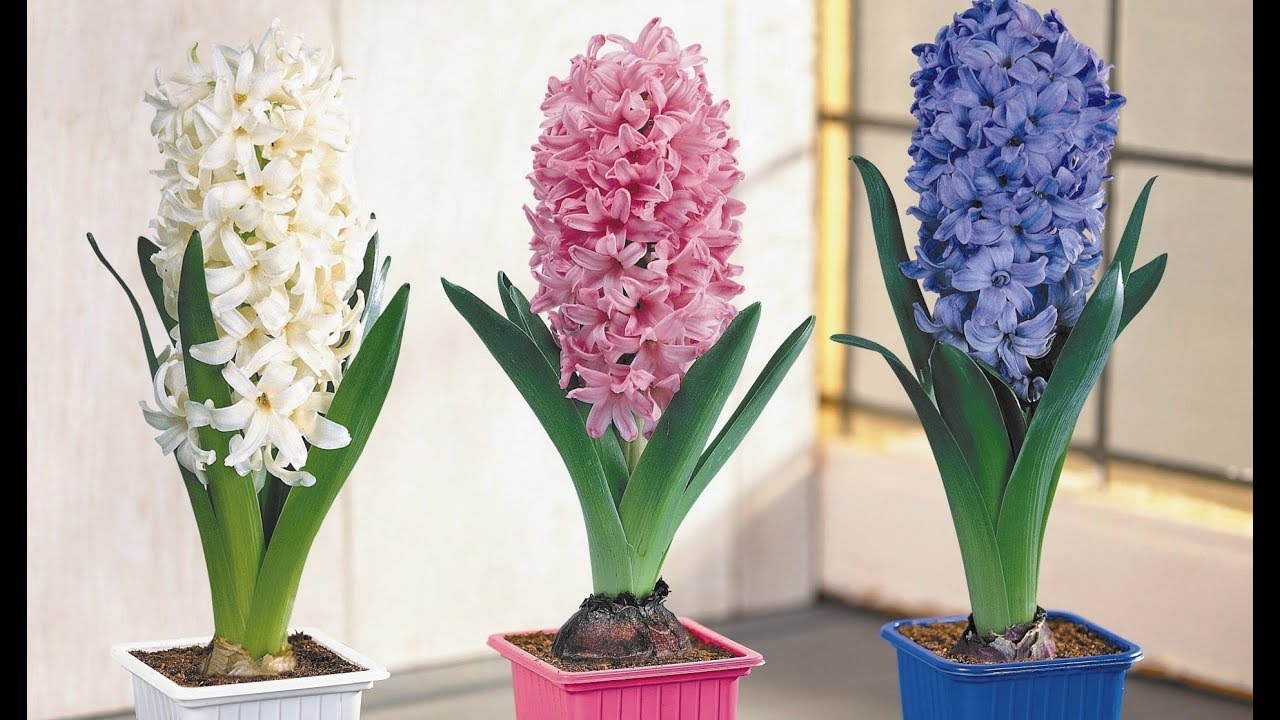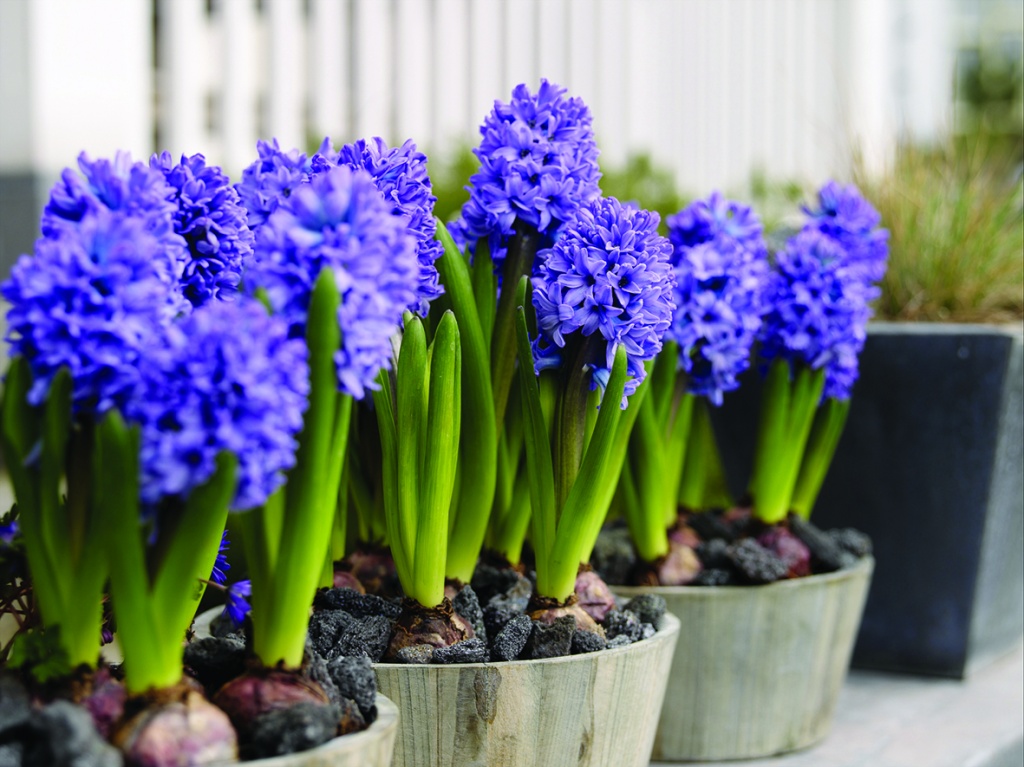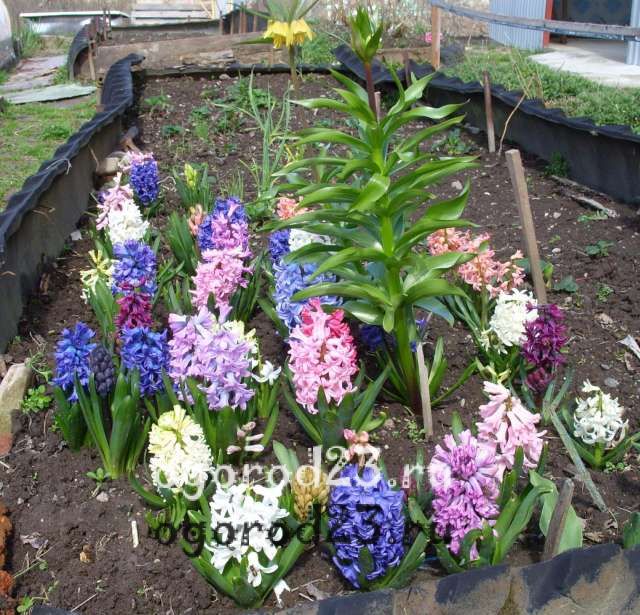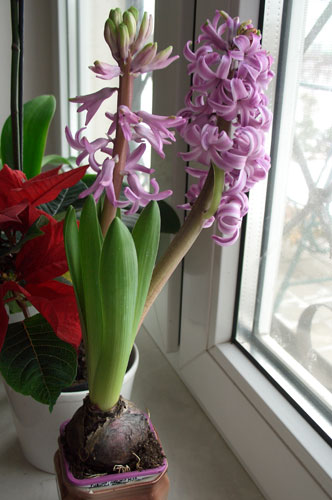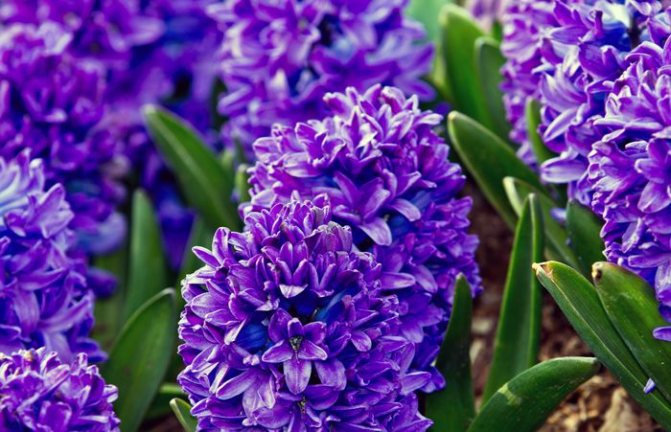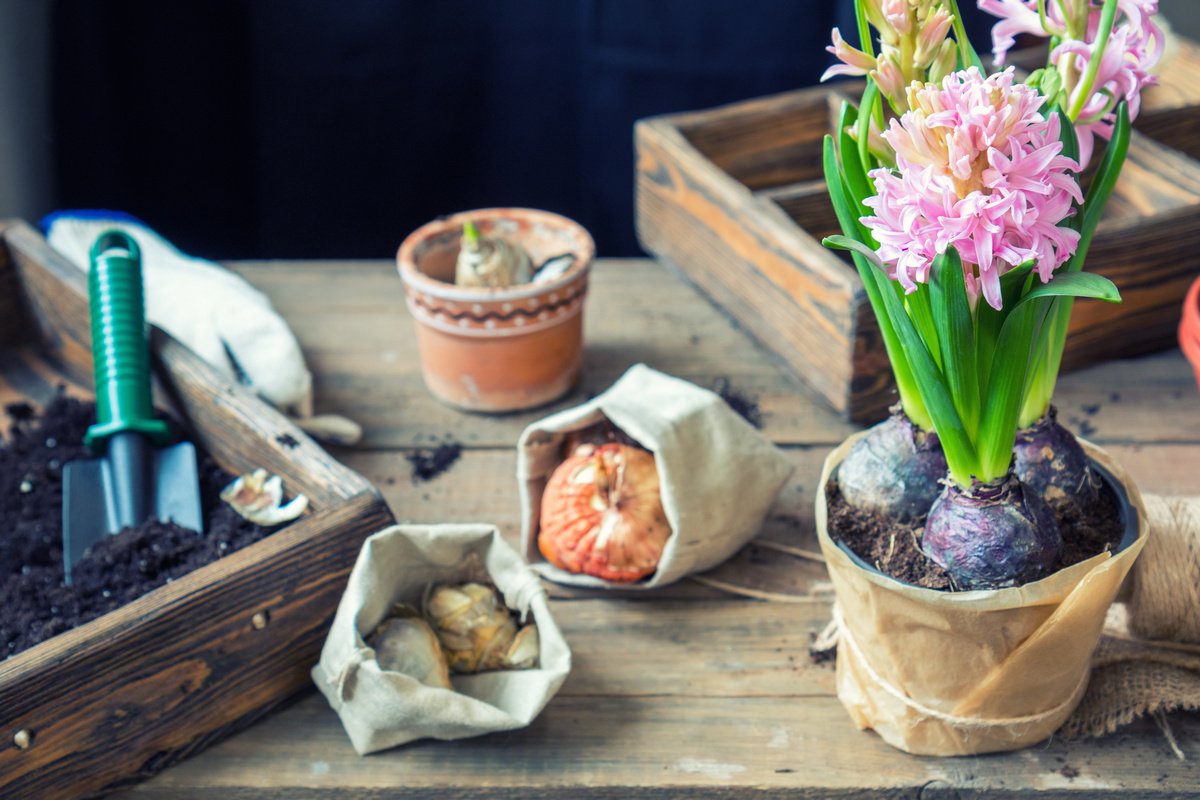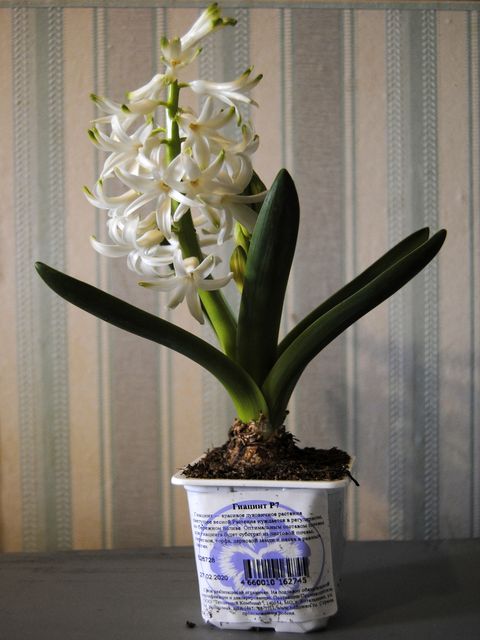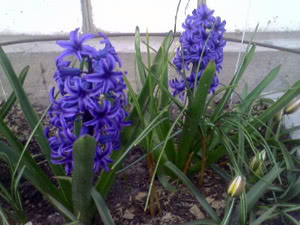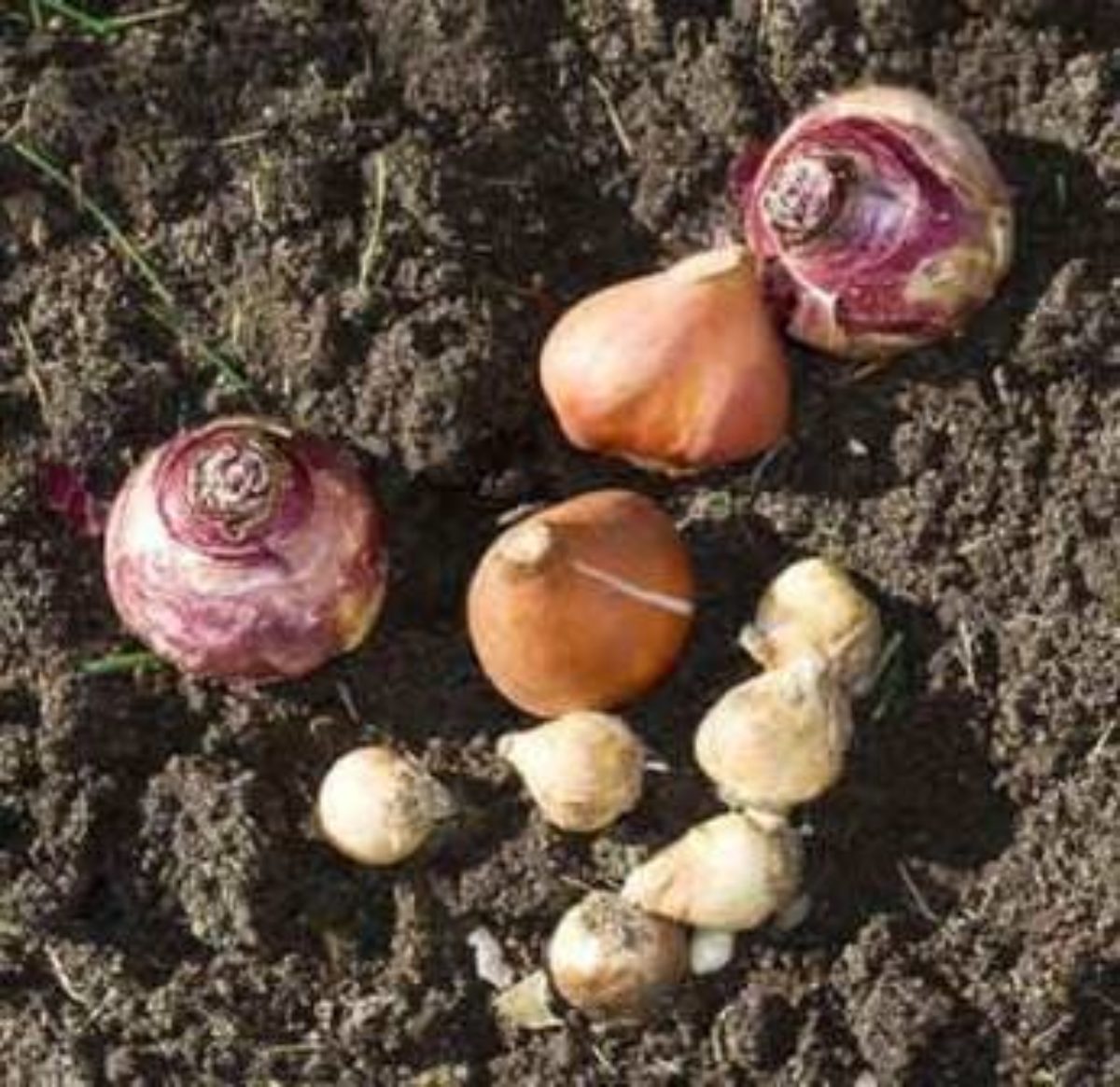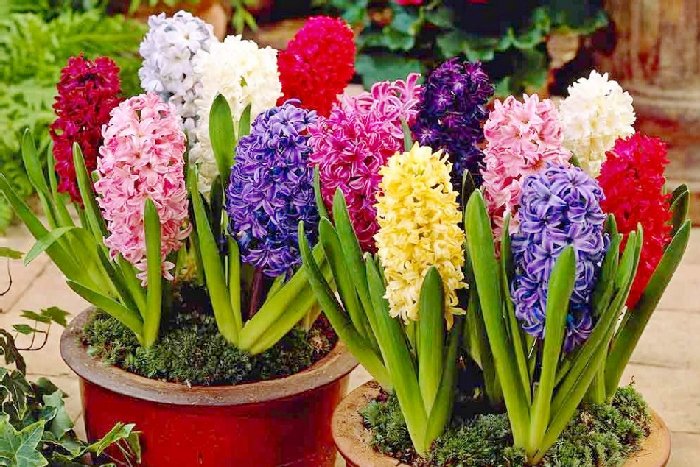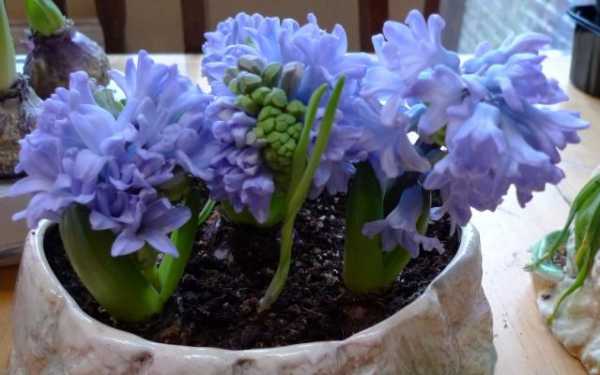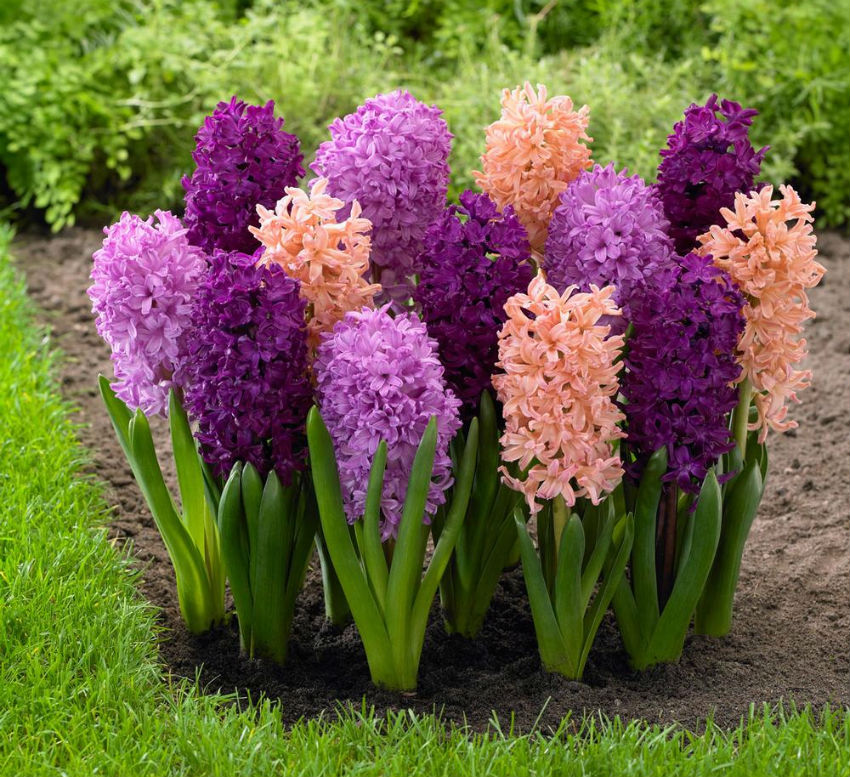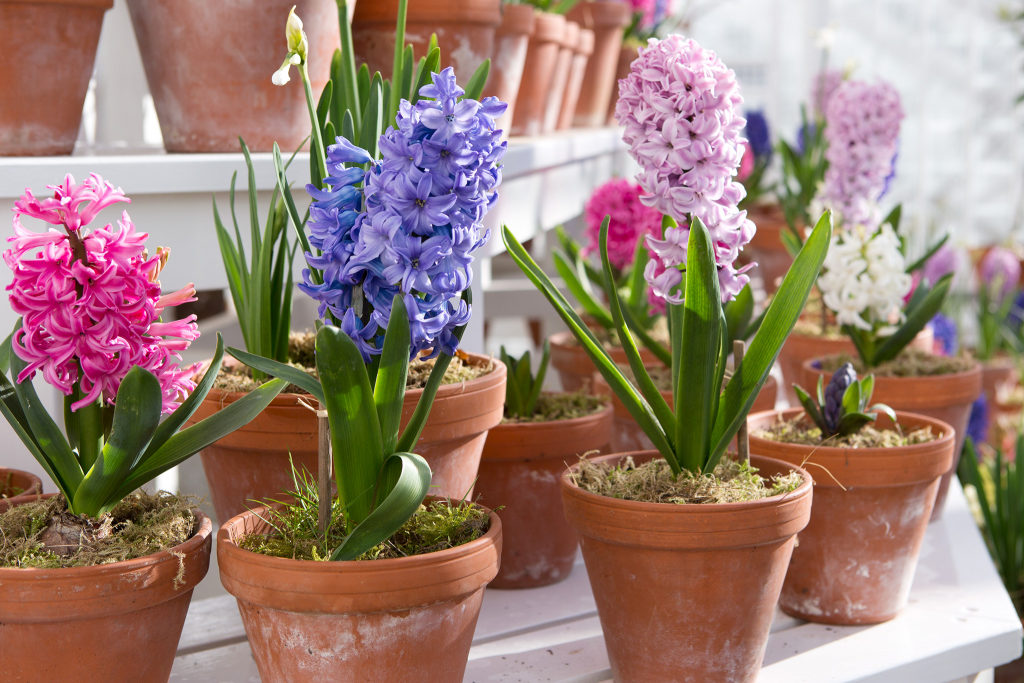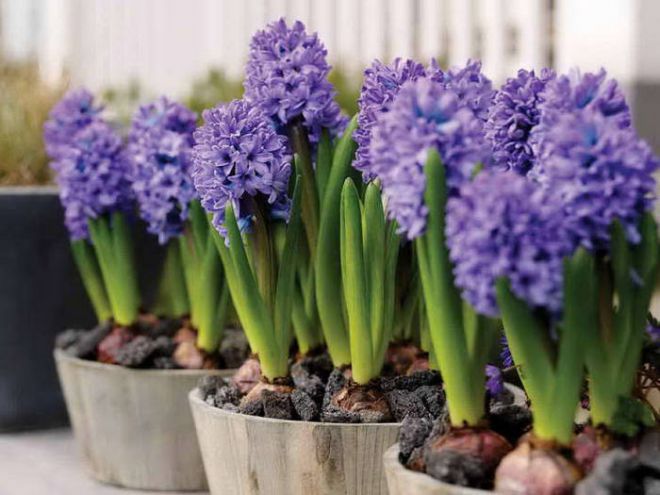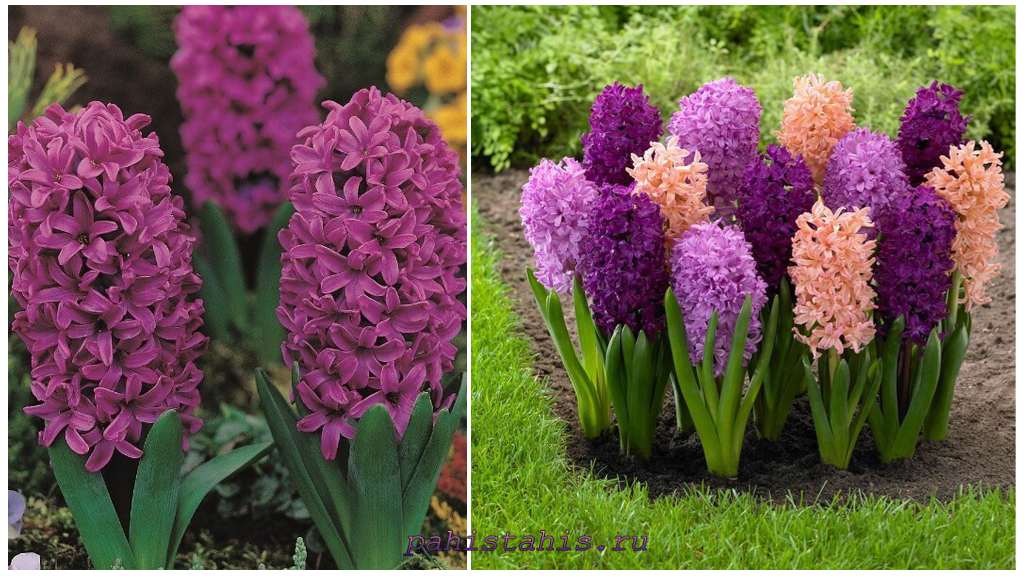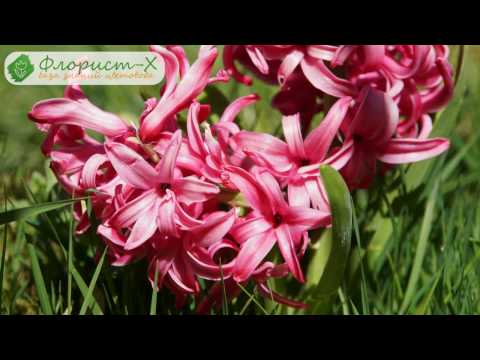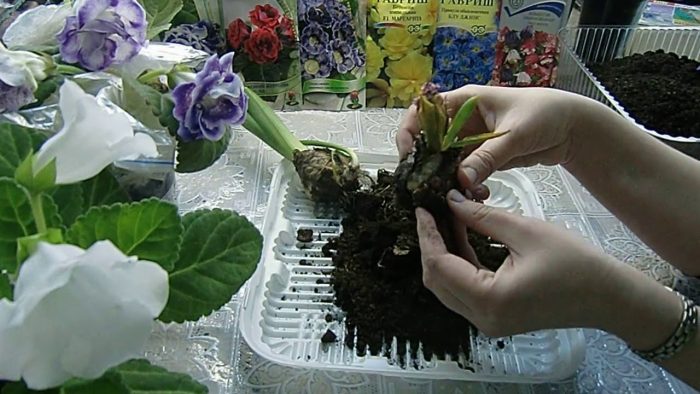Hyacinth care after flowering
When the hyacinth has faded, trim the flower stalk, but continue watering until the leaves are completely yellow. During this time, all nutrients "return" back to the bulb, and, as it were, are preserved in it until the next phase of activity. Water abundantly, but rarely, so that the ground can dry out between waterings.
When the leaves are withered, scoop out the bulb. You must do this no later than the end of June. After digging, dry the hyacinth bulb for 5-7 days in a well-ventilated place at + 20 ° C, (not in the sun, in the shade).
After drying, remove the dead scales and roots. Separate babies from the mother's bulb if they separate easily and have their own roots.
Now you need to give the hyacinth bulb a rest period, which should last at least 90-95 days (about 3 months).
This is a very important stage in the life of a bulb. The quality of its future flowering depends on the storage conditions.
The rest period takes place in two stages:
1) 8 weeks at 25-26 ° C 2) 4 weeks at 17 ° C
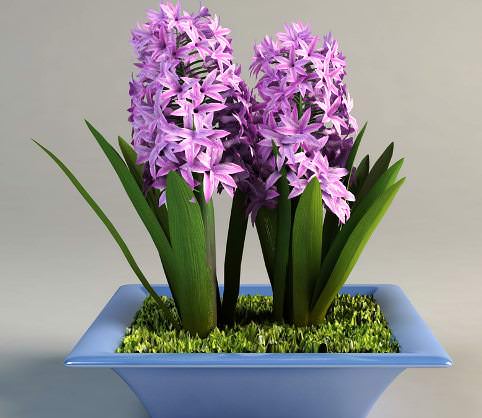
Before planting in the ground, it is recommended to hold them for a couple of days at 5 ° C. If you want to shorten the first stage by 1 week, then after drying, during the first week of storage, maintain the temperature at 30 ° C, and the remaining 1.5 months at 25-26 ° C.
Transplanting hyacinths after flowering
You need to replant the plant in the fall (we are talking about warm regions that do not require digging out the bulbs for the winter). The most suitable period is from mid-September to early October. The hyacinth should have time to take root after planting. If the procedure is carried out later, he may not have time to develop the root system until the cold weather. Planting earlier will cause the flower to grow faster in a warm environment. By the onset of cold weather, the first entrances will appear, which will die on frosty nights.
When planting, the ground should have a temperature in the range of 7 to 13 degrees. You need to adhere to the rules so as not to harm the plant and maintain its health:
- 2-3 weeks before the planned planting, you need to prepare the ground, dig it up and apply fertilizer;
- If necessary, reduce the acidity of the soil so that the plant is comfortable. The easiest way is to add chalk to the soil. Only then can you plant;
- Leave a distance of at least 8 centimeters between flowers. When using small bulbs, the distance is reduced;
- You need to plant tubers to a depth of about 12 centimeters. A small layer of river sand is placed at the bottom of the hole;
- Empty places are filled with soil and watered;
- They insulate plants for the winter. For this, the beds are covered with straw, sawdust, some use fallen leaves. You can use spruce branches and peat. With the onset of spring, the plants need to be opened. The signal for this is the melting of snow.
Proper care, timely digging of bulbs, comfortable conditions during rest will reward with abundant flowering. In the spring, the garden will be filled with aroma, the plants will sparkle with different colors.
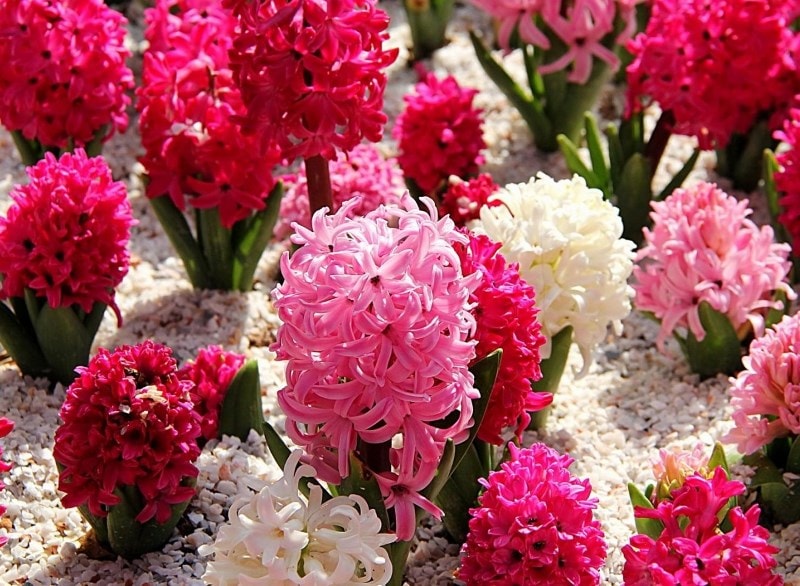
Bloom
If hyacinths of the same variety are planted, then you need to place the tubers at an equal depth and select by size. Then they will bloom at the same time. Simple rules will allow you to enjoy the abundant flowering of one bulb for at least 10 years.
When and how to transplant?
Further, having cut off part of the peduncle, the hyacinth should be transplanted by the transshipment method. This is the transplanting of a plant into a container of a slightly larger diameter without cleaning the roots from the soil substrate. To do this, you need to prepare a pot 2-3 cm larger than the one in which the hyacinth grew.Place a clay shard with the convex side up on the drainage hole in the bottom. Then pour in some coarse sand, which will serve as drainage. Cover the top with garden soil 0.5-1 cm thick.
Carefully remove the hyacinth bulb along with the earthen clod from the pot, being careful not to damage the roots. Hyacinths are usually sold in soft containers that can be cut with scissors. Place the plant in the center of the prepared pot, cover it with soil from the sides (this can be ordinary garden soil or turf mixed with rotted leaf soil). It is impossible to deepen the neck of the root during transplantation, water it moderately. After transshipment, after a few days, you can feed the hyacinths with a weak fertilizer solution.
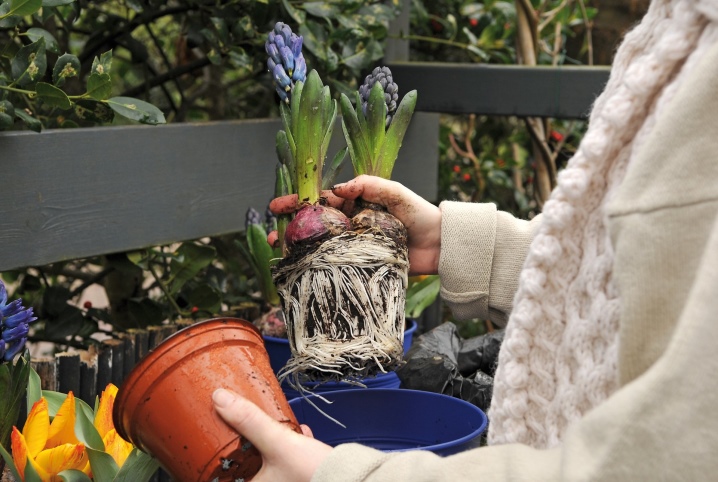
The amount of irrigation and water used should be gradually reduced. Watering should be done as the potted substrate dries completely. When the leaves of the hyacinth turn yellow, watering should be completely stopped. If the cut peduncle has dried completely during this time, you can pull it out of the flower. You can remove the onion from the pot only when the leaves are completely down and dry. You should carefully pull out the bulb, clean it from the ground, cut off the dried roots.
Next, the hyacinth bulbs should be dried. This can be done at room temperature by folding them in a cardboard box and placing them in a shady place. You cannot use plastic containers or plastic bags for this purpose: the bulbs can rot there. It is necessary to dry it until the previously dried leaves become completely thin and transparent.

After drying, the hyacinth bulbs can be stored in a dry place with free access to air. In a room environment, this can be some secluded place on the floor, for example, under a bed or behind a closet. So the bulbs will be stored for 2-3 months until autumn. In no case should it be planted again in a pot for flowering in the room. The plant should gain strength after the previous distillation. The hyacinth will bloom again only after a year or two, and only in the open field.
Therefore, now you should plant the hyacinth bulbs in open ground. This should be done in late September - early October. If you plant them earlier, then the hyacinths will have time not only to take root, but also to grow leaves, which will lead to their freezing in winter. If you are late with planting, then the roots will not have time to grow on the bulbs, and the hyacinths will die in winter.
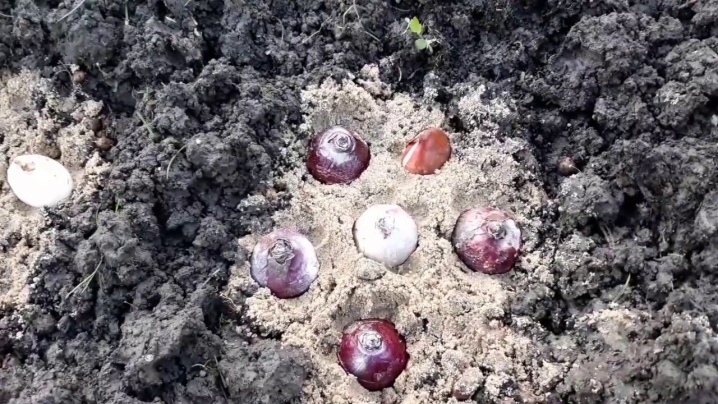
There should be drainage in the holes, since hyacinths do not tolerate stagnant moisture. The soil should be neutral, loose, nutritious. At the bottom of each landing hole, you need to pour some sand, which serves as drainage. Plant the bulbs, slightly pressing the bottoms into the sand, cover with a little sand, then a soil substrate with the addition of a small amount of humus.
They should be planted to a depth equal to the height of three bulbs. That is, if the height of the hyacinth bulb is 6 cm, then the hole should be dug up to a depth of 18 cm.The soil layer above the bulb will be 12 cm in this case. It must be remembered that the planting depth also depends on the composition of the soil. On light sandy, peaty soils, the hole should be deepened by another 2-3 cm, on heavy clay soils, on the contrary, the landing hole should be made 2-3 cm shallower.
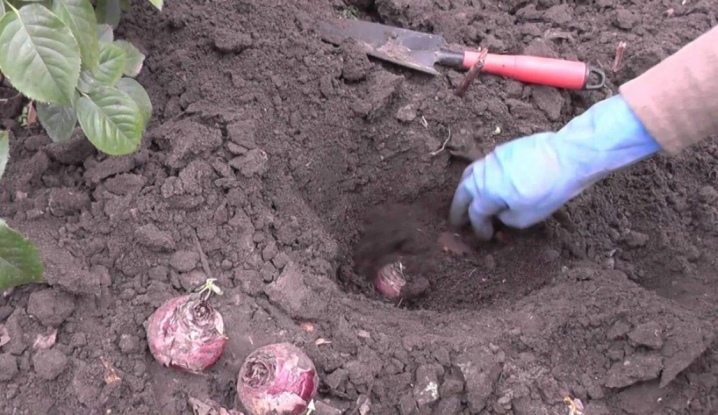
Before planting, the bulbs must be soaked for 30 minutes in a weak solution of potassium permanganate. If the wells were wet before planting, then you do not need to water the hyacinths right away. If the soil was dry, then after planting the plants, it is necessary to water the flower bed.
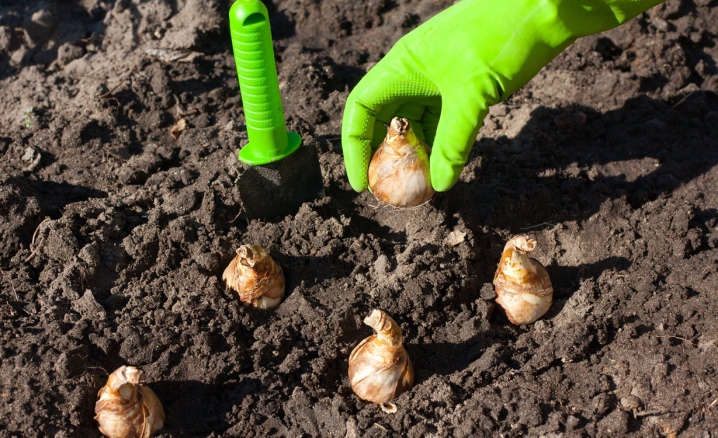
Flowering problems and solutions
Hyacinth may not always bloom on time. This is due to the influence of diseases and pests or improper care of the plant.
REFERENCE!
The flower does not tolerate excess moisture, liquid on inflorescences or leaves. It is recommended to water through the pallet so as not to harm.
Hyacinth does not bloom with the following problems:
- content during a dormant period at a high temperature;
- lack of moisture or its excess;
- scarcity of lighting.
If the reason is unknown, you can try again to dry the bulbs, clean them from rot and excess scales and put them back in a dark place, observing the required temperature regime - up to +5 degrees. When the hyacinth does not bloom due to problems with moisture - its lack or excess, watering should be normalized and the root system should not dry out or rot. If there is little light, you can move the pot to another place - where there is more sunlight.
Careful care of the herbaceous perennial will provide you with magnificent and fragrant flowers, which will delight you with their flowering six months later.
Planting dates for hyacinths for growing in the open field
In most regions of Russia, hyacinths can be planted in the ground from early September to mid-October.
- If the bulbs hit the ground earlier, or the fall turns out to be unusually warm, the plants start growing and die when frost sets in.
- If you are late with planting, the bulbs will not have time to root by the time the soil is frozen.
Nevertheless, it is possible to embed the bulbs in the soil in the first weeks of November. For this, the landing site must be covered with foliage or other suitable material in advance and covered with a film. The soil will keep warm, and the bulbs trapped in it will begin to grow as they should.
Azalea - home care after flowering
Caring for an azalea after flowering consists mainly in preparing it for a dormant period.
The new place for keeping during the wintering period should be shaded.
Location
Taking care of the azalea correctly is, first of all, choosing the right place for it in the house. The plant prefers lighted places, however, as soon as the bush begins to fade, it must be removed in more shaded rooms.
Important! It is better to do it in several tapes. The flower must get used to less illumination, you cannot immediately remove it from the usual environment
Room humidity is another important component when caring for a plant after flowering. Decrease in indicators should not be allowed. Ideally, the humidity should always be at least 70%.
Temperature regime
In addition to lighting, this room should be cooler, only so the azalea can retire and have a good rest before the new season.
The temperature regime also decreases gradually, sharp jumps can provoke the appearance of diseases. The flower will be under stress for a long time and it is quite possible that it will not bloom in time for the next year.
The optimum temperature in the new room is +16 .. + 19 degrees.
Important! Drafts should not be allowed during the wintering period, therefore airing the bush is strictly prohibited.
Watering and fertilizing
Azalea care after flowering consists in correct, not excessive, watering. It is best to water the plant by adding some zircon to the water. After 2-3 such procedures, watering is continued with settled slightly warm water.
So that the plant does not experience stress, you need to water it according to a certain regimen and do not skip a single procedure. After flowering, professionals do not recommend often moistening the soil - 1 watering every 2 weeks is enough.
Attention! Regularly every month, light loosening of the soil should be carried out, avoiding areas close to the stem and root system. In order not to disturb the plant in vain, during the dormant period it is recommended to carry out fertilizing in liquid form.
It is better not to resort to folk methods, but to purchase complex mineral preparations designed specifically for rhododendrons. Their composition must necessarily contain: nitrogen, potassium and phosphorus
In order not to disturb the plant in vain, it is recommended to feed in liquid form during the dormant period. It is better not to resort to folk methods, but to purchase complex mineral preparations designed specifically for rhododendrons.Their composition must necessarily contain: nitrogen, potassium and phosphorus.
It is especially recommended to increase the nitrogen content of the soil. To do this, you can feed the bush with "Uniflor", which helps to restore the bush.
For timely flowering, you need to properly prepare the bush for wintering
When caring for an incredibly beautiful azalea plant, it is important to follow certain rules. Good wintering and a fairly long dormant period help the bush to gain strength, which means it will bloom in a timely manner and abundantly for the next year.
Florists often suffer from the lack of flowering of the bush, try various methods and methods so that the azalea can again form inflorescences. Few people realize that the correct preparation of the azalea for wintering and the timely retirement is what a flower really needs for normal growth and blooming of buds in the future.
Planting hyacinths in the ground: choosing bulbs and places for planting them
Perennial hyacinth is a bulbous crop, the size of the bulb may vary depending on the type of flower. The planting material is considered an adult by the age of 5-6, when it is fully formed. The tuber is a scaly sphere with a bud of renewal - it is this that affects its growth. By the 5th year, adult bulbs usually acquire babies, which are formed near the bottom and are hidden under the scales.
Hyacinth, photo of flowers:

When choosing tubers, you should pay attention to the following nuances:
- Terry bulbs are often smaller than their regular bulbs.
- To grow flowers outdoors, the tuber must have at least 4 cm in diameter, a full-fledged active bud and multiple scales. Elasticity and heaviness are indicators of the healthy state of the bulb.
- The appearance of the bulb should be perfect - no damage, loose sides, mold.
- On the lower part of the tuber (near the bottom), root primordia should be present.
- The bottom of a suitable bulb for planting should be about one and a half to two times smaller than the bulb itself (we are talking about volume).
The key to a long and lush flowering is not only high-quality planting material, but also the planting site itself. You can set up a flower garden near trees or bushes, but not very close to them. The place for plants should be calm, well lit by the sun's rays. The soil is needed loose, if black soil or loam predominates on your site, then it is advisable to add peat to it in advance (sand is also possible). Sod land or deciduous humus are excellent conditions for the development, growth and flowering of hyacinths.
As a fertilizer, organic matter gives good results, but you should not use manure. If the soil is acidic (pH above 6.5), then it should be diluted with dolomite (limestone) flour. Hyacinth tubers do not like excessive moisture very much. If on your site groundwater runs close to the surface (closer than 0.5 m), you cannot do without arranging high beds. In addition, the plants will have to provide a high-quality drainage substrate, as well as make a slight slope of the ridge - for better outflow of water during rains, spring melting of snow. With the arrival of spring, high beds are warmed up faster by the sun's rays, hyacinths bloom much earlier.
What is an onion?
We recommend that you familiarize yourself
A ripe hyacinth bulb consists of tight-fitting scales that remain after the dried fleshy grassy leaves. They grow from the circumference of the bottom, like a flowering stem.
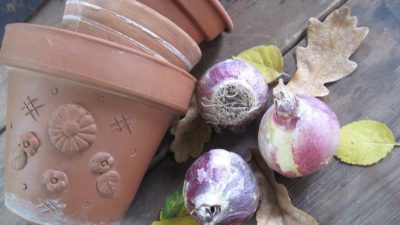
When the bulb wakes up, it gives up all the nutrients to the growth of leaves and buds. The peduncle is pruned immediately after flowering to prevent seed bolls from forming. Their ripening prevents the bulb from developing properly. At the peduncle, the upper part is cut off, and the stem is left. The plant needs it for certain processes. Primroses such as hyacinth can be compared:
- white flower;
- lachenalia;
- snowdrop;
- overflow.
The developmental stages and propagation methods of these plants are similar. When the hyacinths have faded, what to do next can be suggested by the experience of growing tulips, daffodils or muscarias. They are related plants that develop in the same way.
For some time after the end of flowering, the bulb will still expel leaves so that it has something to accumulate nutrients for the next growing season.
After the complete depletion of its nutrients, it will freeze and begin to form a new bulb from the bud at the bottom. The latter forms in the corner of the upper leaf on the stem, inside the old bulb. It is not difficult to understand that this process has begun. The leaves dry up during this period of time and gradually die off completely. Their bases at the root system are covered with a dense skin on top, and the entire structure begins to fill with juices and thicken, forming a new organism.
The bulb will grow actively if there are enough nutrients and moisture. Daughter buds of smaller size, weaker ones, can form near other leaves. They are able to remain in an embryonic state if there is not enough nutrition, or they develop and form independent bulbs, which can be separated and used as planting material in further work.
Babies, as well as the main bulb, require proper care, the purpose of which is to allow the plant to grow in size and become capable of flowering.

Storage conditions for bulbs
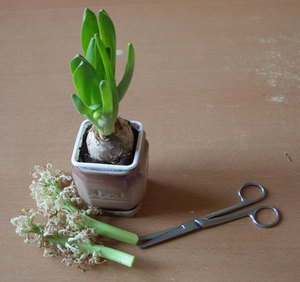 In growing hyacinths, this moment is of great importance. So, before being sent for storage, the bulbs must be disinfected in a manganese solution. Then dry by leaving for a week in the fresh air (not in the sun) or simply in a well-ventilated area. The optimum temperature for this is around 20 ° C.
In growing hyacinths, this moment is of great importance. So, before being sent for storage, the bulbs must be disinfected in a manganese solution. Then dry by leaving for a week in the fresh air (not in the sun) or simply in a well-ventilated area. The optimum temperature for this is around 20 ° C.
Need cleaning from soil and excess scales
Especially carefully it is necessary to separate those under which the children are. It is also good to make cruciform incisions on the bottoms of the bulb.
It is important to disinfect the knife after handling each one. You can wipe it with rubbing alcohol
During sorting, babies are separated from the bulbs if they are easy to detach and have established roots. The seed is put in boxes or paper bags, sprinkled with sawdust.
There are several stages in the storage of bulbs:
- For 8 weeks, the bulbs are kept at t 25 ° C;
- After that, it must be reduced to 18 ° C;
- A few days before disembarkation, it is good to keep them in a cold room (t 4-5 ° C). This will help them adapt to the external environment.
Indoor humidity is also important. The air should be dry, but not dry enough to dry out the bulbs. Good ventilation is also needed. Also, open field bulbs can be stored at home at a temperature of about 5 ° C. This is done only with adult specimens.
What if the bulb is sick? The leaves can turn yellow for this reason as well. In such cases, the planting material must be immediately dug up, held in a dark solution of manganese and put to dry separately from others, having treated them with special preparations.
Hyacinth bulbs contain oxalic acid. It can be irritating for people with sensitive skin, so it is best to protect your hands when working with them.
Preparation of planting material and soil
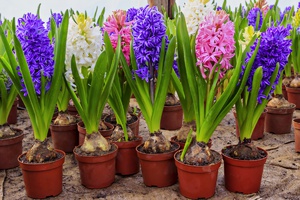 The soil must be prepared before planting hyacinth bulbs in it. When choosing a place, it is better to give preference to a garden bed, which is located under a slight slope. In this way, flooding, which is very dangerous for the plant, can be avoided. Alternatively, bulk beds with sides are suitable. They will also protect hyacinth from groundwater.
The soil must be prepared before planting hyacinth bulbs in it. When choosing a place, it is better to give preference to a garden bed, which is located under a slight slope. In this way, flooding, which is very dangerous for the plant, can be avoided. Alternatively, bulk beds with sides are suitable. They will also protect hyacinth from groundwater.
It is better to dig up the soil in advance so that it has time to settle. From fertilizers, minerals and humus can be added to the soil. Ash and dolomite flour are quite applicable.
The bulbs are sorted before planting.
It is important that they are not damaged or rotted. Then they are disinfected in potassium permanganate
The procedure is also good as disease prevention
The children formed during the storage period are carefully disconnected and planted in separate containers. Here they will grow and develop
After the pre-planting treatment, the bulbs are planted in holes, making sand shirts for them. Sand is poured onto the bottom of the planting hole, on top they are also sprinkled with sand, and only then with soil.
These flowers were brought to Europe in the distant 18th century. And they invariably enjoy well-deserved popularity. How the plant will develop in the future depends on proper hyacinth care after flowering. After all, one bulb, with the right approach, can delight with flowering for about 10 years.
Is it still possible to distill the hyacinth again?
Is it really impossible to reuse hyacinth bulbs for forcing and see them blooming on your windowsill next spring, and not plant them in open ground? Sometimes they say: "If you really want to, then you can." This will require special training.
Fertilizing watering is used to preserve nutrients in the bulb. Prepare the following mixture: 1 part potassium salt, 2 hours superphosphate, 1.5 parts ammonium nitrate. Dissolve 1-1.5 g of the mixture in 1 liter of water.
You can also use commercially available fertilizers, bird droppings, blood meal, and more. Moisten the potting soil with water before fertilizing. Fertilizing watering begins to be applied after the end of flowering and is completed by the time the leaves completely die off.
After the leaves wilted, the bulbs are left in the soil for some time to ripen, and then dug out.
But keep in mind that such preparation still does not guarantee 100% re-flowering at home.
The hyacinth in the pot has faded: What to do next?
For the holiday on March 8, beloved women are often given flowers in pots: tulips, daffodils, hyacinths. It is pleasant to receive such a gift: flowers in the ground delight with flowering much longer than cut flowers. But the natural pattern is that any flowering ends sooner or later. And then the question arises: what to do with the bulbs next, can they be saved?
In Europe, for example, the bulbs of distilled flowers are ruthlessly thrown away - there they are considered disposable. But in the hands of caring Russian women, they are able to bloom again, the main thing is to provide the plants with proper care, to do everything right. So, the hyacinths have faded, what's next? Let's give them a second life!
- Personal experience: How NOT to do it! Learning from mistakes.
- Step by step: What to do with the hyacinth in the pot after flowering?
- The hyacinth has faded and what's next? Summer storage of bulbs.
- Planting bulbs in the fall in the ground.
- Will hyacinth bloom again?
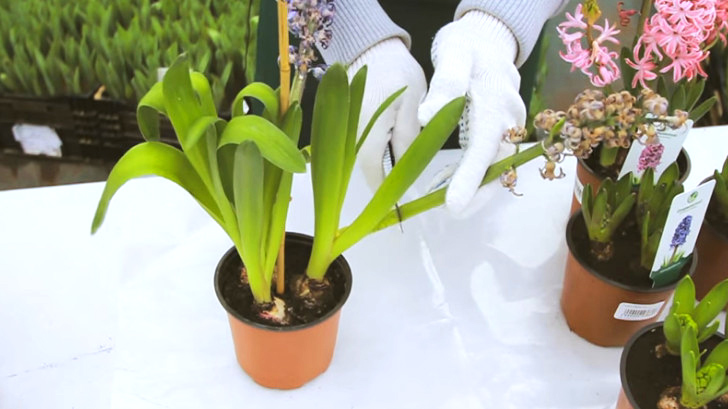
Storing and caring for bulbs after flowering
The most important point in growing hyacinths is keeping the bulbs at home. It is during storage that flower buds are laid in the bulb. The further flowering of the plant also depends on the correct storage.
If the storage conditions of the bulbs are violated, and the digging is done too late, then flowering will be poor. You need to store the bulbs for three months.
How to keep bulbs at home:
1. Bulbs of hyacinths are dug up and dried in a shaded place. This may take a week. Dry the bulbs at a temperature of 20 degrees.
2. Next, the bulbs are cleaned of the soil, the remnants of the roots are removed and sorted. Examine the bulbs for disease and damage. Weak material is discarded. I put the sorted bulbs in storage. Small bulbs are stored separately from large ones. The name of the variety is signed on paper storage bags.
The entire storage process takes place in two stages, which are necessary for the plant to set flower buds.
- The first stage lasts two months. The bulbs are stored at room temperature in paper bags. The storage temperature is 25 degrees.
- The second stage lasts one month. This is the pre-planting storage of the bulbs.The temperature should be within 18 degrees. During storage, they monitor not only the temperature, but also the humidity of the air. If there is insufficient moisture, the hyacinth bulbs dry out.
If for some reason it is necessary to shorten the first stage of storage, then the temperature can be raised to 30 degrees. Under such conditions, it takes 1.5 months to dry hyacinths.
What happens if hyacinth is left in the ground
Dutch flower growers known all over the world believe that under no circumstances should hyacinth bulbs be left in the ground. All bulbous primroses, including hyacinths, after the flowering period, proceed to ripening the bulb, then into a state of dormancy. At this time, they are very sensitive to changes in weather conditions: high humidity, temperature changes.
The bulbs left in the ground are endangered by rodents who are eager to try them. The emerging "kids" find it difficult to survive and grow up in such conditions, most of them will die. In central Russia, conditions are extremely unfavorable; moreover, it is impossible to control the condition of the bulbs in the soil, which makes the process of digging them up mandatory.
Important! It is possible to create suitable conditions for the maturation and laying of healthy flower buds, control over them, and maintain the necessary conditions for storing planting material only if it is removed from the ground. In the southern regions with warm winters, you do not need to dig up the bulbs every season, but to conduct an examination, separate the "children", identify bulbs damaged by rodents and diseased bulbs, you will have to resort to this procedure
In addition, it contributes to the preservation of varietal traits and lush flowering.
In the southern regions with warm winters, you do not need to dig up the bulbs every season, but to carry out an examination, to separate the "children", to identify bulbs damaged by rodents and diseased bulbs, you will have to resort to this procedure. In addition, it contributes to the preservation of varietal traits and lush flowering.
Hyacinth care after flowering at home and in the garden does not cause any particular difficulties, but it requires compliance with certain conditions and attention. It is necessary to dig up the bulbs in time, send them to storage correctly, prepare a site for planting and planting them in the fall in a time sufficient for rooting. In the spring, again, expect the appearance of new shoots and the miracle of the emergence of beautiful inflorescences.
The sight of a blooming hyacinth, especially if this plant is grown independently, causes pride in its owner. The time and labor spent are returned with bright colors and the delicate aroma of an amazing flower.



